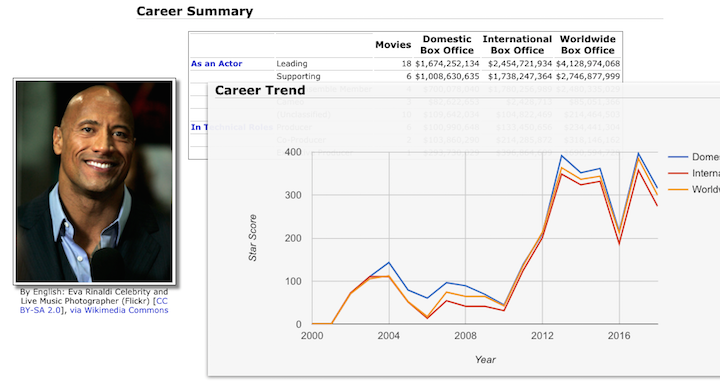New at The Numbers: Analysis of Actors’ Career Trends
January 18, 2018
In our continued quest to provide the most in-depth analysis of the movie industry, we’re pleased to announce some updates to our people pages today. We have new analysis of career histories, breakdowns for acting and technical credits, and summaries of the acting or technical records people can lay claim to. Let’s look at these new features one at a time, using the cast and crew of Jumanji: Welcome to the Jungle as example.
Each actor’s summary tab has a new chart that looks at their Star Score over the years. The history shown in the example above is for Dwayne (formerly “The Rock”) Johnson, who just took over from Samuel L. Jackson as the top-ranked global star, as determined by our Star Score. To calculate that number, we give actors 100 points if they are a leading actor or part of the leading ensemble for the biggest box office hit of the year, 99 points is they are in the second biggest hit, etc.. We calculate the Star Score by adding up all of those scores for any given year and the two previous years. Keep in mind that, since the year has just started, a lot of actors, like Kevin Hart, have seen their star power plummet in 2018, because their 2015 hits don’t count for 2018, but did in 2017, and they haven’t earned any points from films that opened in 2018, yet. Other actors, like Karen Gillan, are still building their resumé, so their chart shows a sharp upwards spike between 2016 and 2018.
The chart provides a snapshot of the waxing and waning fortunes of leading stars in the industry, and we’ve added it for every actor who has appeared in a top-100 hit since 2000.
The next new section deals with an actor’s credits, divided up by leading / lead ensemble roles and supporting roles. We’ve added more detail to these breakdowns, including opening weekend and domestic share. Here, for example, are Karen Gillan’s lead and lead ensemble roles:
To determine which roles count as “leading,” we look at the poster for the movie. If someone appears on the poster, they have a leading role. If they don’t, we consider them to have a supporting role. If more than four characters appear on the poster, we consider them to be “lead ensemble” members, which is also included among an actor’s lead roles.
We’ve added a similar system for technical credits, which we now break out by type in the same way. For example, here are Jake Kasdan’s directing credits:
Technical roles are split out for writers, directors, and producers. For example, Guillermo del Toro has credits in all three roles, sometimes for the same movie.
In addition to dividing the credits up into different roles, there is also a new section for records on each person’s page. Since our Star Records section is so large, these lists can be quite long. Here are the beginning of Kevin Hart’s records:
This list shows at a glance Hart’s rapid rise as a domestic star, peaking (so far) as the number 2 star at the domestic box office in 2016, and also how he still has some way to go to become a similar force internationally. The links will take you through to the detailed lists in each case. An actor’s Summary tab shows their ranks in the major records sections, while the Acting Credits tab has links to many other ranks, including how they stack up by creative type, genre, and so on. Kevin Hart is, for example, the second-highest grossing performer at the domestic box office in concert movies. There is a lot of information here and it paints a fascinating picture.
We’re working on much more, so look out for announcements soon on further new features at the site.
Career Trend
Acting and Technical Credit Details


Star Records

Filed under: Samuel L. Jackson, Guillermo del Toro, Kevin Hart, Dwayne Johnson, Jake Kasdan, Karen Gillan

